Complete Solutions to EXAMPLE of chapter MECHANICAL PROPERTIES OF FLUID of Class 11 book with complete answers and questions
| Class 11 | PHYSICS |
| Chapter | MECHANICAL PROPERTIES OF FLUID |
| MBD | EXAMPLE |
| Number Of Questions | 100 |
| Academic Year | 2023-24 |
The bags and suitcases are provided with broad handles. Explain why.
View SolutionWhat is one torr of pressure?
View SolutionOn what factors, the atmospheric pressure at a place depends?
View SolutionStraws are used to take soft drinks. Why?
View SolutionWhat do you mean by gauge pressure?
View SolutionExplain why Hydrostatic pressure is a scalar quantity even though pressure is force divided by area.
View SolutionWhat do you mean by buoyancy ?
View SolutionWhat do you mean by buoyancy ?
View SolutionDoes Archimedes's principle hold in a vessel in free fall?
View SolutionWhat does the sudden fall, gradual fall and gradual increase in barrometer level indicate?
View SolutionWhy two holes are made to empty an oil tin?
View SolutionIf few drops of water are introduced in the barometer tube, what would be the effect on the barometric height?
View SolutionWhy water does not come out of a dropper unless its rubber head is pressed hard?
View SolutionWhy mercury is used in barometer?
View SolutionFor flow of a fluid to be turbulent
View SolutionWhat is the value of Reynolds number for streamline flow?
View SolutionWhat is continuity equation?
View SolutionWrite the dimensions of Reynolds number.
View SolutionIn streamline flow, what is the velocity of the liquid in contact with the containing vessel?
View SolutionWhat should be the properties of a liquid to satisfy Bernoulli's theorem?
View SolutionWhy is that a liquid set in motion comes to rest after some time?
View SolutionWrite two factors affecting viscosity. Which one is more viscous , pure water or saline water?
View SolutionWhat is the effect of density on viscosity of liquids and gases.
View SolutionWhy machines are sometimes jammed in winter?
View SolutionWhy small air bubbles rises slowly through the liquid whereas the bigger one rises rapidly?
View SolutionWhy does velocity increase when water flowing in a broader pipe enters narrower pipe?
View SolutionWhy is it dangerous to stand on the edge of the platform near the railway line when the train is passing by?
View SolutionAre the dimensions of coefficient of viscosity and coefficient of friction same?
View SolutionHotter liquids flow faster than cold liquids. Why?
View SolutionExplain why A drop of liquid under no external forces is always spherical in shape.
View SolutionMercury does not cling to glass. Why?
View SolutionMercury does not cling to glass. Why?
View SolutionWhy antiseptics have low surface tension?
View SolutionWhat happens to surface tension when impurity is mixed in a liquid?
View SolutionBy which phenomenon water rises from the root to the leaves of plants?
View SolutionWhy hot soup tastes better than cold soup?
View SolutionTwo drops of mercury when brought together coalesce into one. Why?
View SolutionWhy the nib of a pen is split?
View SolutionWhat type of clothes should we wear in summer ?
View SolutionWhat is the effect of highly soluble impurities on the surface tension of a liquid .
View SolutionWhat is the effect of less soluble impurities on the surface tension of a liquid.
View SolutionWhat is the effect on the angle of contact when the temperature of a liquid is increased?
View SolutionWhat is the shape of meniscus of mercury in contact with glass?
View SolutionThe shape of liquid meniscus is concave. Will it rise or fall in a capillary tube?
View SolutionWhy clothes become water-proof when wax is rubbed on them?
View SolutionWhat do you understand by molecular range?
View SolutionHow do tree draw water from ground?
View SolutionThe radius of a capillary tube is doubled. What changes will take place in height of the capillary rise?
View SolutionExplain why The blood pressure in humans is greater at the feet than at the brain?
View SolutionExplain why Atmospheric pressure at a height of about 6 km decreases to nearly half of its value at the sea level, though the height of the atmosphere is more than 100 km
View SolutionExplain why Hydrostatic pressure is a scalar quantity even though pressure is force divided by area.
View SolutionExplain why The angle of contact of mercury with glass is obtuse, while that of water with glass is acute.
View SolutionExplain why Water on a clean glass surface tends to spread out while mercury on the same surface tends to form drops. (Put differently, water wets glass while mercury does not.)
View SolutionExplain why Surface tension of a liquid is independent of the area of the surface
View SolutionExplain why Water with detergent disolved in it should have small angles of contact.
View SolutionExplain why A drop of liquid under no external forces is always spherical in shape.
View SolutionFill in the blanks using the word(s) from the list appended with each statement: Surface tension of liquids generally . . . with temperatures (`increases // decreases`)
View SolutionFill in the blanks using the word(s) from the list appended with each statement: Viscosity of gases . . . With temperature, whereas viscosity of liquids . . . With temperature (`increases // decreases`)
View SolutionFill in the blanks using the word(s) from the list appended with each statement: For solids with elastic modulus of rigidity, the shearing force is proportional to ... , while for fluids it is proportional to . . . (`shear strain // rate of shear strain`)
View SolutionFill in the blanks using the word(s) from the list appended with each statement: For a fluid in a steady flow, the increase in flow speed at a constriction foliows (`conservation of mass // Bernoulli’s principle`)
View SolutionFill in the blanks using the word(s) from the list appended with each statement:For the model of a plane in a wind tunnel, turbulence occurs at a ... speed for turbulence for an actual plane (`greater // smaller`)
View SolutionExplain why To keep a piece of paper horizontal, you should blow over, not under, it
View SolutionExplain why When we try to close a water tap with our fingers, fast jets of water gush through the openings between our fingers
View SolutionExplain why The size of the needle of a syringe controls flow rate better than the thumb pressure exerted by a doctor while administering an injection
View SolutionExplain why A fluid flowing out of a small hole in a vessel results in a backward thrust on the vessel
View SolutionExplain why A spinning cricket ball in air does not follow a parabolic trajectory
View SolutionA 50 kg girl wearing high heel shoes balances on a single heel. The heel is circular with a diameter 1.0 cm. What is the pressure exerted by the heel on the horizontal floor ?
View SolutionToricelli’s barometer used mercury. Pascal duplicated it using French wine of density `984 kg m^-3`. Determine the height of the wine column for normal atmospheric pressure.
View SolutionA vertical off-shore structure is built to withstand a maximum stress of `10^9` Pa. Is the structure suitable for putting up on top of an oil well in the ocean ? Take the depth of the ocean to be roughly 3 km, and ignore ocean currents.
View SolutionA hydraulic automobile lift is designed to lift cars with a maximum mass of 3000 kg. The area of cross-section of the piston carrying the load is `425 cm^2`. What maximum pressure would the smaller piston have to bear ?
View SolutionA U-tube contains water and methylated spirit separated by mercury. The mercury columns in the two arms are in level with 10.0 cm of water in one arm and 12.5 cm of spirit in the other. What is the specific gravity of spirit ?
View SolutionIn the previous problem, if 15.0 cm of water and spirit each are further poured into the respective arms of the tube, what is the difference in the levels of mercury in the two arms ? (Specific gravity of mercury = 13.6)
View SolutionCan Bernoulli’s equation be used to describe the flow of water through a rapid in a river? Explain.
View SolutionDoesit matter if one uses gauge instead of absolute pressuresin applying Bernoulli's equation ? Explain
View SolutionGlycerine flows steadily through a horizontal tube of length 1.5 m and radius 1.0 cm. If the amount of glycerine collected per second at one end is `4.0xx 10^-3 kg s^-1`, what is the pressure difference between the two ends of the tube ? (Density of glycerine = `1.3xx 10^3 kg m^-3` and viscosity of glycerine = 0.83 Pa s). [You may also like to check if the assumption of laminar flow in the tube is correct].
View SolutionIn a test experiment on a model aeroplane in a wind tunnel, the flow speeds on the upper and lower surfaces of the wing are `70 m s^-1`and `63 m s^-1` respectively. What is the lift on the wing if its area is `2.5 m^2` ? Take the density of air to be `1.3 kg m^-3`
View SolutionFigures 10.23(a) and (b) refer to the steady flow of a (non-viscous) liquid. Which of the two figures is incorrect ? Why ?:
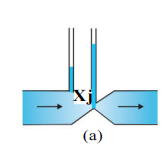

View SolutionThe cylindrical tube of a spray pump has a cross-section of `8.0 cm^2` one end of which has 40 fine holes each of diameter 1.0 mm. If the liquid flow inside the tube is `1.5 m min^-1`, what is the speed of ejection of the liquid through the holes ?
View SolutionA U-shaped wire is dipped in a soap solution, and removed. The thin soap film formed between the wire and the light slider supports a weight of `1.5xx 10^-2 N` (which includes the small weight of the slider). The length of the slider is 30 cm. What is the surface tension of the film ?
View SolutionFigure 10.24 (a) shows a thin liquid film supporting a small weight = `4.5xx 10^-2` N. What is the weight supported by a film of the same liquid at the same temperature in Fig. (b) and (c) ? Explain your answer physically:
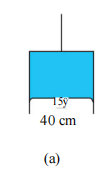
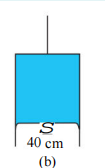
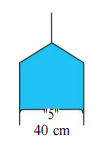
View SolutionWhat is the pressure inside the drop of mercury of radius 3.00 mm at room temperature ? Surface tension of mercury at that temperature (`20^@C`) is `4.65xx10^-1 N m^-1`The atmospheric pressure is `1.01xx 10^5Pa`. Also give the excess pressure inside the drop.
View SolutionWhat is the excess pressure inside a bubble of soap solution of radius 5.00 mm,given that the surface tension of soap solution at the temperature (20^@C) is 2.50xx 10 2 N in 1 ? If an air bubble of the same dimension were formed at depth of 40.0 cm inside a container containing the soap solution (of relative density 1.20), what would be the pressure inside the bubble ? (1 atmospheric pressure is 1.01xx 105 Pa).
View SolutionA tank with a square base of area 1.0 `m^2` is divided by a vertical partition in the middle. The bottom of the partition has a small-hinged door of area `20 cm^2`. The tank is filled with water in one compartment, and an acid (of relative density 1.7) in the other, both to a height of 4.0 m. compute the force necessary to keep the door close.
View SolutionA manometer reads the pressure of a gasin an enclosure asshown in Fig. 10.25 (a) When a pump removes some of the gas, the manometer reads as in Fig. 10.25 (b) The liquid used in the manometersis mercury and the atmospheric pressure is 76 cm of mercury.Give the absolute and gauge pressure of the gas in the enclosure for cases (a) and (b), in units of cm of mercury.:
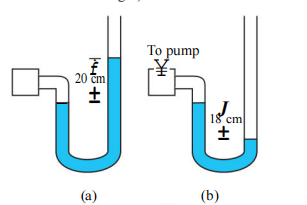
View SolutionA manometer reads the pressure of a gasin an enclosure asshown in Fig. 10.25 (a) When a pump removes some of the gas, the manometer reads as in Fig. 10.25 (b) The liquid used in the manometersis mercury and the atmospheric pressure is 76 cm of mercury.How would the levels change in case (b) if 13.6 cm of water (immiscible with mercury) are poured into the right limb of the manometer ? (Ignore the small change in the volume of the gas).:
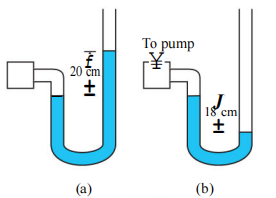
View SolutionTwo vessels have the same base area but different shapes. the first vessel takes twice the volume of water than the second, vessel requires to fill upto a particular common height. Is the force exerted by water on the base of the vessel the same in the two cases? If so, why do the vessel filled with water to that same height give differnt readings on a weighing scale?
View SolutionDuring blood transfusion the needle isinserted in a vein where the gauge pressure is 2000 Pa. At what height must the blood container be placed so that blood may just enter the vein ? [Use the density of whole blood from Table 10.1],
View SolutionIn deriving Bernoulli's equation, we equated the work done on the fluid in the tube to its change in the potential and kinetic energy. Do the dissipative forces become more important asthe fluid velocity increases ? Discuss qualitatively.
View SolutionIn deriving Bernoulli's equation, we equated the work done on the fluid in the tube to its change in the potential and kinetic energy. Do the dissipative forces become more important asthe fluid velocity increases ? Discuss qualitatively.
View SolutionIn deriving Bernoulli's equation, we equated the work done on the fluid in the tube to its change in the potential and kinetic energy . What is the largest average velocity of blood How in an artery of diameter `2xx 10^-3` m if the flow must remain laminar ? Discuss qualitatively.
View Solution(a) What is the largest average velocity of blood flow in an artery of radius `2 xx 10^-3` m if the flow must remain laminar? (b) What is the corresponding flow rate? (Taking viscosity of blood to be `2.084 xx 10^-3 Pa s)`
View SolutionA plane is in level flight at constant speed and each of its two wings has an area of `25 m^2`. If the speed of the air is `180 km//h` over the lower wing and `234 km//h` over the upper wing surface, determine the plane’s mass. (Take air density to be `1 kg m^-3`)
View SolutionIn Millikan’s oil drop experiment, what is the terminal speed of an uncharged drop of radius `2.0xx 10^5` m and density `1.2xx 10^3 kg m^-3`. Take the viscosity of air at the temperature of the experiment to be `1.8xx 1 0^-5` Pa s. How much is the viscous force on the drop at that speed ? Neglect buoyancy of the drop due to air
View SolutionMercury has an angle of contact equal to `140^@` with soda lime glass. A narrow tube of radius 1.00 mm made of this glass is dipped in a trough containing mercury. By what amount does the mercury dip down in the tube relative to the liquid surface outside ? Surface tension of mercury at the temperature of the experiment is 0.465 `N m^-1`. Density of mercury = `13.6xx 10^3 kg m^-3`.
View SolutionTwo narrow bores of diameters 3.0 mm and 6.0 mm are joined together to form a U-tube open at both ends. If the U-tube contains water, what is the difference in its levels in the two limbs of the tube ? Surface tension of water at the temperature of the experiment is `7.3xx 10^-2 N m^-1 '. Take the angle of contact to be zero and density of water to be `1.0xx 10^3 kg m^- 3` (`g = 9.8 m s^-2`) .
View SolutionIt is known that density `rho` of air decreases with height y (in metres) as :
`rho = rho_(0) e^(-y//y_0)` where `rho_0 = 1.25 kg m^-3` is the density at sea level and `y_0` is a constant. This density variation is called the law of atmospheres. Obtain this law assuming the temperature of atomoshpere remains constant (isothermal conditions). Also assume that the value of g remains constant.
View SolutionA large ballon of volume `1425 m^3` is used to lift a payload of 400 kg. Assuming that the ballon maintains constant radius as it rises. How high does it rise? `(Take Y_0 = 8000 m` and `rho_(He) = 0.18 kg m^-3)`
View SolutionA tall cylinder is filled with viscous oil. A round pebble is dropped from the top with zero initial velocity.From the plot shown in the figure. indicate the one that represents the velocity (v) of the pebble as a function of time (t).
View SolutionWhich of the following diagrams (shown in the figure) doesnot represent a streamline flow?
View SolutionState and prove Bernoulli's theorem for liquid having streamline flow.
View Solution
EXAMPLE questions and complete solutions for chapter MECHANICAL PROPERTIES OF FLUID of MBD of Class 11